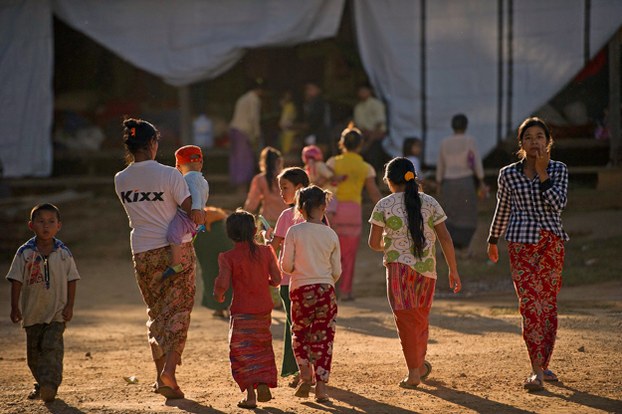




Fighting between Myanmar’s army and armed ethnic rebels in the country’s restive Shan state has been temporarily suspended while the Shan State Army-North (SSA-N) holds talks with President Thein Sein about ending the clashes.
“Our central executive committee (CEC) member Maj. Sai Naw Lake left for [the capital] Naypyidaw yesterday to see the president and discuss how to stop the fighting in our area generally,” Col. Sai La, spokesman of the Shan State Progress Party/Shan State Army, told RFA’s Myanmar Service.
Fighting resumed between the army and Shan State Army-North, the armed branch of the Shan State Progress Party, on Oct. 6, forcing an estimated 10,000 people to flee their homes in the central part of Shan state.
Heavy fighting took place on Nov. 16 and 17, during which government forces attacked rebel troops with six helicopters and two fighter jets, Sai La said.
The current hostilities stopped briefly on Thursday when the government’s peace negotiating committee invited the rebel group for talks.
But Sai La indicated that the effort may not be enough to permanently end the clashes.
“If we want to talk deeply about the fighting, we need to have at least five or six CEC members talking about stopping war,” he said. “Having only one CEC member doing it is not natural.”
The two sides had a cease-fire agreement in place from January 2012, but both have blamed each other for the outbreak of new fighting.
The SSN-A was not among the eight armed ethnic groups that signed a so-called nationwide cease-fire agreement (NCA) with the government on Oct. 15.
The SSN-A and other rebels groups that have been battling army forces believe the government has stepped up attacks on them in retaliation for not participating in the peace pact before the country’s general elections were held on Nov. 8.
On Wednesday, Sai La had called on Thein Sein to end the hostilities against the SSA-N, noting that the government-backed Union Peacemaking Working Committee (UPWC) had been instructed to negotiate a truce.
A day earlier, leaders of the Shan Nationalities League for Democracy (SNLD) and the Shan Nationalities Democratic Party (SNDP) asked the president during a meeting in Yangon to end the fighting in Shan state as soon as possible and assist displaced residents.
The Myanmar army also has been involved in repeated clashes with Ta’ang National Liberation Army (TNLA) soldiers, who operate in a large area of Shan state, including a recent skirmish in Mongmit township.
The TNLA, Myanmar National Democratic Alliance Army (MNDAA) and Arakan Army (AA) have been fighting the military in Shan state’s Kokang self-administered zone near the Chinese border, where several hundred Myanmar soldiers have been killed.
The three ethnic armies were not invited to join the NCA, but had expressed interest in doing so.
All-inclusive peace process
Meanwhile, the United Nationalities Alliance (UNA) political organization and the eight cease-fire groups on Friday discussed a peace process that would include the ethnic armies that did not sign the accord.
About 20 representatives from the eight groups attended the meeting in the commercial capital Yangon, during which they also talked about war refugees from the current conflicts in Shan and Kachin states.
The military’s escalation in Shan state has spilled into southern Kachin state where government troops have launched ground and air attacks on Kachin Independence Army (KIA) soldiers in Mohnyin township since Nov. 14, according to local media.
The KIA, which also refused to sign the NCA in October, has been at war with the military since June 2011, when a 17-year ceasefire broke down.
“We explained to the representatives our position that we wanted to begin political dialogues during the current government term to try to include the rest of the groups in the signing of the NCA,” said UNA member Aye Thar Aung. “We also want the new government to carry on the political dialogues that we start during this government term.”
In January, Aung San Suu Kyi’s opposition National League for Democracy (NLD) party, which swept the general elections, will form a new government, taking over from the Union Solidarity and Development Party (USDP), which has ruled the country since 2011.
The Union Election Commission (UEC), the body responsible for tallying the votes, announced Friday that it had received the last remaining ballots from Kachin state.
Five NLD candidates, three USDP candidates, two candidates from the Lisu National Development Party and one candidate from National Unity Party won seats in the national and state parliaments.
By Wai Mar Tun and Phone Myint for RFA’s Myanmar Service. Translated by Khet Mar. Written in English by Roseanne Gerin.